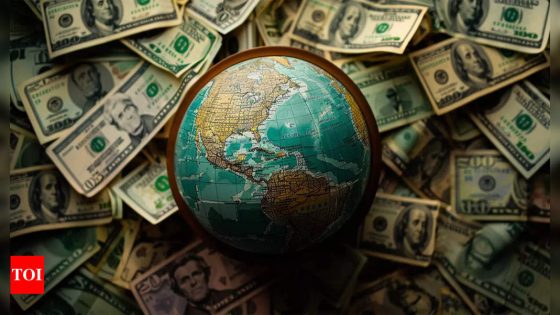India crosses the $100 billion mark in remittances! In the fiscal year 2019-20, which was an election year, India received remittances amounting to $83.2 billion. However, in the following year, 2020-21, the remittances slowed down to $80.2 billion, possibly due to the impact of the COVID pandemic. In the years 2014-15 and 2015-16, India received $65.6 billion and $61.3 billion in remittances, respectively.
An ET analysis by Gayatri Nayak of data spanning the past 25 years reveals that in four out of five election years, remittances reached their peak until the election year and then experienced a slowdown.
India has consistently been the top recipient of remittances from its diaspora. In the fiscal year 2022-23, the remittances surpassed the $100 billion mark, reaching $112 billion, with a record-breaking $29 billion in the December quarter alone.
However, the question remains whether this upward trend will persist. An analysis of the factors driving inward remittances is necessary to understand the dynamics at play.
Also Read | India closes gap with China as weight in MSCI equity index hits record high; $2 billion inflows expected
Inward remittances refer to the money sent by Indians residing abroad to their families back home for their daily sustenance. In India’s balance of payments data, these remittances are categorized under “private transfers” and constitute a significant source of foreign currency resources for the economy, says the financial daily’s report.
Several factors influence the flow of remittances to a country, including the number of its citizens working abroad and the employment prospects they find in various foreign markets, as well as the salaries and benefits offered to them.
For India, significant opportunities first arose in the 1970s when the oil boom in the Persian Gulf countries created a demand for Indian semiskilled workers.
This led to some initial pick up in remittances. Subsequently, in the 1990s, the IT boom generated a vast market for skilled Indian IT professionals in developed countries in North America and Europe. “This led to a surge in remittances to India leading India to emerge as one of the top recipients of remittances,” the report says.
Also Check | Top 10 Countries With Highest Foreign Exchange Reserves Including Gold: Where do India, China, US stand? Check list
In an open economy, a country can benefit from remittances in several ways, even when foreign currency enters through various channels. Since the 1990s, when India liberalized its economy, several avenues for foreign currency inflows have opened up, such as foreign portfolio flows, foreign direct investment, NRI deposits, and external commercial borrowings, among others.
However, these inflows are part of the capital account in the balance of payments and can be reversed. In contrast, remittances provide a stable and permanent source of foreign currency inflows, which can also be used to finance the country’s current account deficit.
The connection between elections and inward remittances remains uncertain, as no conclusive research or analysis by regulatory bodies has established a definitive link. However, historical data indicates that there are often noticeable increases in remittances around the time of general elections, despite the absence of a proven causal relationship.
India’s record-breaking $112 billion in remittances raises questions about whether this trend will persist. It is possible that the diaspora sent funds earlier than usual or compensated for slower growth in previous years, the ET analysis says. Nevertheless, examining long-term patterns suggests that the growth rate of remittances may decelerate in the coming years.
An ET analysis by Gayatri Nayak of data spanning the past 25 years reveals that in four out of five election years, remittances reached their peak until the election year and then experienced a slowdown.
India has consistently been the top recipient of remittances from its diaspora. In the fiscal year 2022-23, the remittances surpassed the $100 billion mark, reaching $112 billion, with a record-breaking $29 billion in the December quarter alone.
However, the question remains whether this upward trend will persist. An analysis of the factors driving inward remittances is necessary to understand the dynamics at play.
Also Read | India closes gap with China as weight in MSCI equity index hits record high; $2 billion inflows expected
Inward remittances refer to the money sent by Indians residing abroad to their families back home for their daily sustenance. In India’s balance of payments data, these remittances are categorized under “private transfers” and constitute a significant source of foreign currency resources for the economy, says the financial daily’s report.
Several factors influence the flow of remittances to a country, including the number of its citizens working abroad and the employment prospects they find in various foreign markets, as well as the salaries and benefits offered to them.
For India, significant opportunities first arose in the 1970s when the oil boom in the Persian Gulf countries created a demand for Indian semiskilled workers.
This led to some initial pick up in remittances. Subsequently, in the 1990s, the IT boom generated a vast market for skilled Indian IT professionals in developed countries in North America and Europe. “This led to a surge in remittances to India leading India to emerge as one of the top recipients of remittances,” the report says.
Also Check | Top 10 Countries With Highest Foreign Exchange Reserves Including Gold: Where do India, China, US stand? Check list
In an open economy, a country can benefit from remittances in several ways, even when foreign currency enters through various channels. Since the 1990s, when India liberalized its economy, several avenues for foreign currency inflows have opened up, such as foreign portfolio flows, foreign direct investment, NRI deposits, and external commercial borrowings, among others.
However, these inflows are part of the capital account in the balance of payments and can be reversed. In contrast, remittances provide a stable and permanent source of foreign currency inflows, which can also be used to finance the country’s current account deficit.
The connection between elections and inward remittances remains uncertain, as no conclusive research or analysis by regulatory bodies has established a definitive link. However, historical data indicates that there are often noticeable increases in remittances around the time of general elections, despite the absence of a proven causal relationship.
India’s record-breaking $112 billion in remittances raises questions about whether this trend will persist. It is possible that the diaspora sent funds earlier than usual or compensated for slower growth in previous years, the ET analysis says. Nevertheless, examining long-term patterns suggests that the growth rate of remittances may decelerate in the coming years.
Source Agencies



